CBSE Sample Papers for Class 12 Physics Paper 3 are part of CBSE Sample Papers for Class 12 Physics. Here we have given CBSE Sample Papers for Class 12 Physics Paper 3.
CBSE Sample Papers for Class 12 Physics Paper 3
| Board | CBSE |
| Class | XII |
| Subject | Physics |
| Sample Paper Set | Paper 3 |
| Category | CBSE Sample Papers |
- All questions are compulsory. There are 26 questions in all.
- This question paper has five sections: Section A, Section B, Section C, Section D and Section E.
- Section A contains five questions of 1 mark each. Section B contains five questions of 2 marks each. Section C contains twelve questions of 3 marks each. Section D contains one value based question of 4 marks and Section E contains three questions of 5 marks each.
- There is no overall choice. However, an internal choice has been provided in 1 question of 2 marks, 1 question of 3 marks and all the 3 questions of 5 marks weightage. You have to attempt only 1 of the choices in such questions.
- You may use the following values of physical constants wherever necessary :
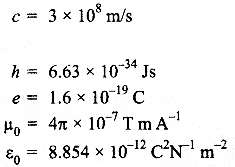
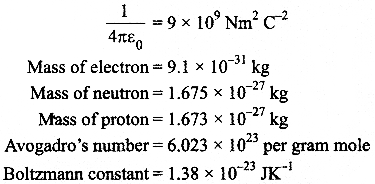
Questions :
SECTION : A
Question 1.
If the angle between the pass axis of polarizer and the analyser is 45°, write the ratio of the ‘ intensities of original light and the transmitted light after passing through the analyser.
Question 2.
You are given following three lenses. Which two lenses will you use as an eyepiece and as an objective to construct an astronomical telescope?
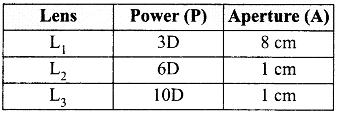
Question 3.
Write the following electromagnetic waves in ascending order with respect to their frequencies: X-rays, microwaves, UV rays and radio waves.
Question 4.
What is sky wave propagation?
Question 5.
Magnetic field lines can be entirely confined within the core of a toroid, but not within a straight solenoid. Why?
SECTION : B
Question 6.
The figure shows a plot of three curves a, b, c, showing the variation of photocurrent v/s collector plate potential for three different intensities I1 I2 and I3 having frequencies v1 v2 and v3 respectively incident on a photosensitive surface. Point out the two curve for which the incident radiations have same frequency but different intensities.
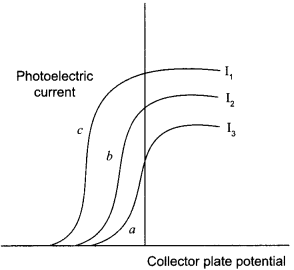
Question 7.
What type of wavefront will emerge from a
(i) point source, and
(ii) distant light source?
Question 8.
Two nuclei have mass numbers in the ratio 1 : 2. What is the ratio of their nuclear densities?
Question 9.
A cell of emf ‘E’ and internal resistance ‘V’ is connected across a variable resistor ‘R’ Plot a graph showing the variation of terminal potential ‘V’ with resistance R. Predict from the graph the condition under which ‘V’ becomes equal to ‘E’.
Question 10.
(i) Can two equipotential surfaces intersect with each other? Give reasons.
(ii) Two charges -q and +q are located at points A (0,0, -a) and B (0,0, +a) respectively. How much work is done in moving a test charge from point P (7, 0, 0) to Q (-3, 0, 0)?
SECTION : C
Question 11.
A radioactive nucleus ‘A’ undergoes a series of decays according to the following scheme :
![]()
The mass number and atomic number of A are 180 and 72 respectively. What are these numbers for A4 ?
Question 12.
An electron and a proton are accelerated through the same potential. Which one the two has
(i) greater value of de Broglie wavelength associated with it and
(ii) less momentum? Justify your answer.
Question 13.
By what percentage will the transmission ranges of TV tower be affected when the height of the tower is increased by 21 %?
Question 14.
Derive an expression for drift velocity of free electrons in a conductor in terms of relaxation time.
Question 15.
In a single slit diffraction experiment, when tiny circular obstacle is placed in the path of light from a distant source, a bright spot is seen at the centre of the shadow of the obstacle. Explain why? State two points of difference between the interference pattern obtained in Young’s double slit experiment and the diffraction pattern due to a single slit.
Question 16.
A thin conducting spherical shell of radius R has charge Q spread uniformly over its surface. Using Gauss’s law, derive an expression for an electric field at a point outside the shell. Draw a graph of electric field E(r) with distance r from the centre of the shell for 0 ≤ r ≤ ∝.
Question 17.
Why are high frequency carrier waves used for transmission?
OR
What is meant by term modulation’? Draw a block diagram of a simple modulator for obtaining an AM signal.
Question 18.
Three identical capacitors C1, C2 and C3 of capacitance 6 μF each are connected to a 12 V battery as shown :
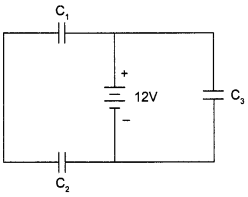
Find
(i) charge on each capacitor
(ii) equivalent capacitance of the network
(iii) energy stored in the network of capacitors
Question 19.
(a) The energy levels of an atom are as shown below. Which of them will result in the transition of a photon of wavelength 275 nm?
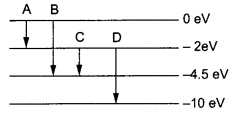
(b) Which transition corresponds to emission of radiation of maximum wavelength?
Question 20.
(a) Define self inductance. Write its S.I. units.
(b) Derive an expression for self inductance of a long solenoid of length l, cross-sectional area A having N number of turns.
Question 21.
The figure shows experimental set up of a meter bridge. When the two unknown resistances X and Y are inserted, the null point D is obtained 40 cm from the end A. When a resistance of 10Ω is connected in series with X, the null point shifts by 10 cm.Find the position of the null point when the 10Ω resistance is instead connected in series with resistance ‘Y’. Determine the values of the resistances X and Y.
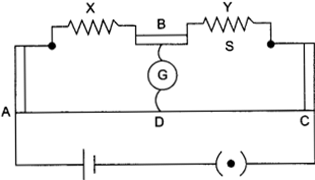
Question 22.
Derive the expression for force per unit length between two long straight parallel current carrying conductors. Hence define one ampere.
OR
Explain the principle and working of a cyclotron with the help of a schematic diagram. Write the expression for cyclotron frequency.
SECTION : D
Questin 23.
Shivani was interested to gift something to her mother on her birthday. But she could not decide what to give her mother.She asked her brother. Her brother advised to gift a microwave oven to the mother. But their father said it is a wastage of money. They convinced him for a microwave and ultimately her father was agreed for microwave.
- hat qualities Shivani and her brother possess?
- State how a microwave oven works?
SECTION : E
Question 24.
(i) Draw a circuit diagram to study the input and output characteristics of an n-p-n transistor in its common emitter configuration. Draw the typical input and output characteristics.
(ii) Explain, with the help of a circuit diagram, the working of n-p-n transistor as a common emitter amplifier.
OR
How is a zener diode fabricated so as to make it a special purpose diode? Draw I-V characteristics of zener diode and explain the significance of breakdown voltage. Explain briefly, with the help of a circuit diagram, how a p-n junction diode works as a half wave rectifier
Question 25.
Trace the rays of light showing the formation of an image due to a point object placed on the axis of a spherical surface separating the two media of refractive indices n1 and n2. Establish the relation between the distances of the object, the image and the radius of curvature from the central point of the spherical surface. Hence derive the expression of the lens makers formula.
OR
Draw the labelled ray diagram for the formation of image by a compound microscope. Derive the expression for the total magnification of a compound microscope. Explain why both the objective and the eyepiece of a compound microscope must have short focal lengths.
Question 26.
(a) Derive an expression for the average power consumed in a series LCR circuit connected to a.c. source in which the phase difference between the voltage and the current in the circuit is Φ.
(b) Define the quality factor in an a.c. circuit. Why should the quality factor have high value in receiving circuits? Name the factors on which it depends.
OR
(i) Derive the relationship between the peak and the rms value of current in an a.c. circuit.
(ii) Describe briefly, with the help of labelled diagram, working of a step-up transformer. A step-up transformer converts a low voltage into high voltage. Does it not violate the principle of conservation of energy? Explain.

For constructing an astronomical telescope, the objective should have the maximum diameter. Of the three lenses given, L1 has the maximum diameter so, use lens L1 as an objective. The eyepiece should have the highest power for better magnification. Therefore, we use lens L3 as an eyepiece.
The given electromagnetic waves can be arranged in ascending order with respect to their frequencies as :
Radio waves < Microwaves < UV rays < X-rays
The type of propagation in which radio waves are transmitted towards the sky and are reflected by the ionosphere towards the desired location on earth is called sky wave propagation.
Magnetic field lines form closed loops around a current – carrying wire. The geometry of a straight solenoid is such that magnetic field lines cannot loop around circular wires without spilling over to the outside of the solenoid. The geometry of a toroid is such that magnetic field lines can loop around electric wires without spilling over to the outside. Hence, magnetic field lines can be entirely confined within the core of a toroid, but not within a straight solenoid.
SECTION : B
(i) For a point source, wavefront will be spherical,
(ii) For a distant light source, the wavefronts will be plane.
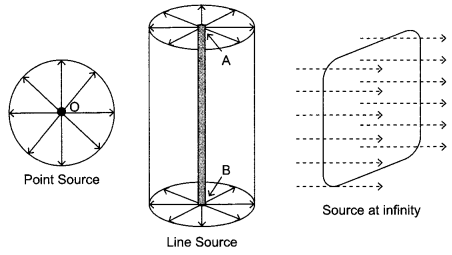
Nuclear density is independent of mass number. Hence, both the atoms have the same nuclear density.
i.e., d1 : d2 = 1 : 1
V becomes equal to E when no current flows through the circuit.
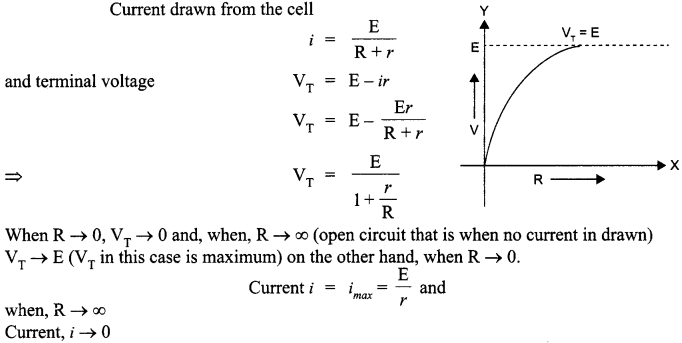
Hence, can say that when resistance increases from R = 0 to R = ∝ then VT increases from minimum to maximum and current decreases from
maximum to minimum value.
Answer 10.
(i) Two equipotential surfaces cannot intersect with each other because when they will intersect,then at a point the electric field will have two directions, which is not possible.
(ii) Potential at P (7, 0, 0)
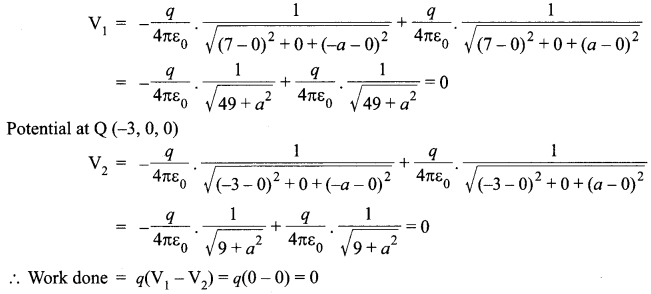
SECTION : C
Answer 11.
![]()
∴ The mass number of A4 = 172 and the atomic number of A4= 69
Answer 12.
(i) The de Broglie wavelength associated with potential V is
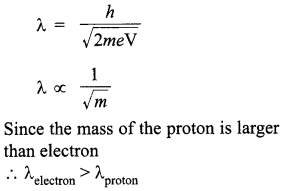
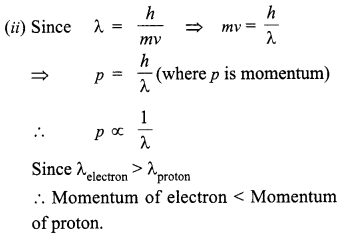
Answer 13.
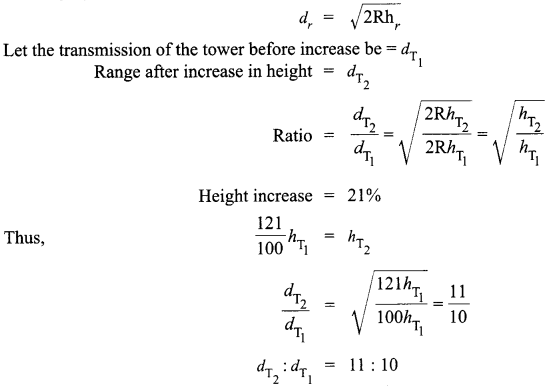
Answer 14.
If there are N electrons and the velocity of the ith electron at a given time is vi where, i = (1, 2, 3,…N), then
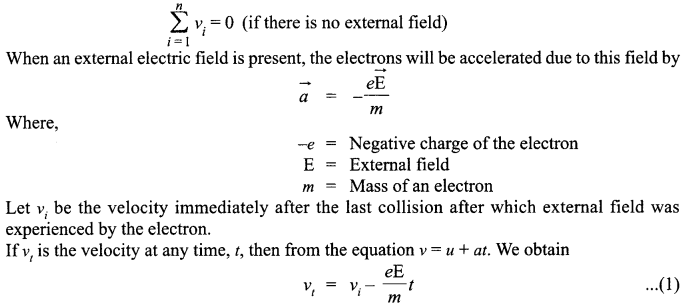
For all the electrons in the conductor, average value of v. is zero. The average of vt is vd or drift velocity. This is the average velocity experienced by an electron in an external electric field. There is no fixed time after which each collision occurs. Therefore, we take the average time after which one collision takes place by an electron.
Let this time, also known as relaxation time, be t. Substituting this in equation (1)
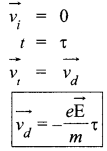
Then, Negative sign shows that electrons drift opposite to the applied field.
Answer 15.
A bright spot is observed when a tiny circular object is placed in the path of light from a distant source in a single slit diffraction experiment because light rays flare into the shadow region of the circular object as they pass the edge of the tiny circular object. The light from all the edges of the tiny circular object are in phase with each other. Thus they form a bright spot at the centre of the shadow of the tiny circular object. The two differences between the interference patterns obtained in Young’s double slit experiment and the diffraction pattern due to a single slit are as follows: The fringes in the interference pattern obtained from diffraction are of varying width, while in case of interference, all are of the same width. The bright fringes in the interference pattern obtained from diffraction have a central maximum followed by fringes of decreasing intensity, whereas in case of interference, all the bright fringes are of equal intensity.
Answer 16.
According to Gauss law,
![]()
Where, q is the point charge,
E is electric field due to the point charge,
dA is a small area on the Gaussian surface at any distance,
e0 is the proportionally constant.
For a spherical shell at distance r from the point charge, the integral § dA is merely the sum of all differential of dA on the sphere.
Therefore,

Therefore, for a thin conducting spherical shell of radius R and charge Q, spread uniformly over its surface, the electric field at any point outside the shell is


The graph of electric field E(r) with distance r from the centre of the shell for 0 ≤ r ≤ ∝.
Answer 17.
For transmitting a signal, the antenna should have a size comparable to the wavelength of the signal (atleast λ/4 in dimension), where λ is the wavelength. If the frequency of the signal is small, then its wavelength becomes very large and it is impractical to make those large antennas for the corresponding large wavelengths. For higher frequencies, wavelength is smaller, which is the reason why high frequency carrier waves are used for transmission.
OR
The process of superimposing information containing in a low frequency signal on a high frequency signal is called modulartion

Answer 18.
Existing diagram can be redrawn as follows :
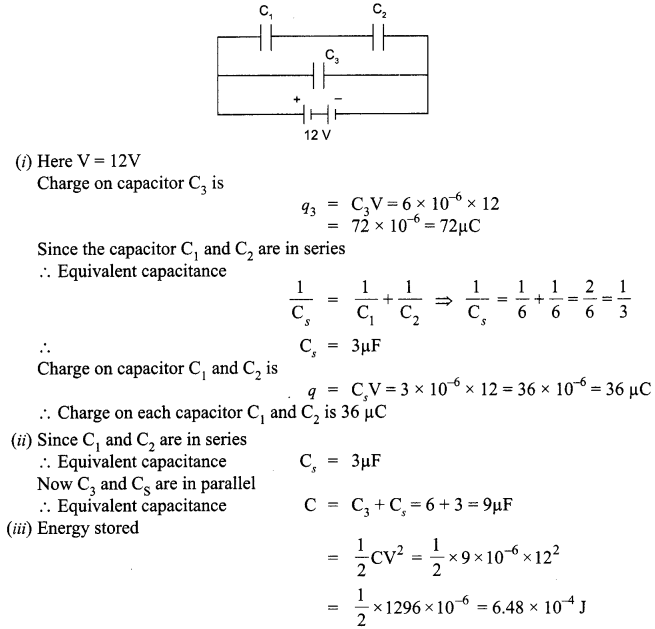
Answer 19.
(a) Energy transitions for A, B, C and D are :
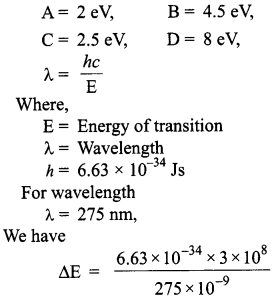
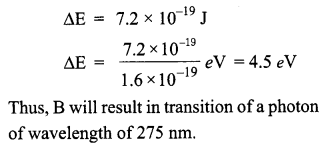
(b)
![]()
For maximum wavelength, energy transition should be minimum. A undergoes minimum energy transition.
A = 2 eV
Thus, photon in A will have the maximum wavelength.
Answer 20.
(a) The phenomenon in which emf is induced in a single isolated coil due to change of flux through the coil by means of varying the current through the same coil is called self inductance. S.I. unit of inductance is henry (H).
(b) Magnetic field B inside a solenoid carrying a current i is B = μ0 n i
Let n be the number of turns per unit length.
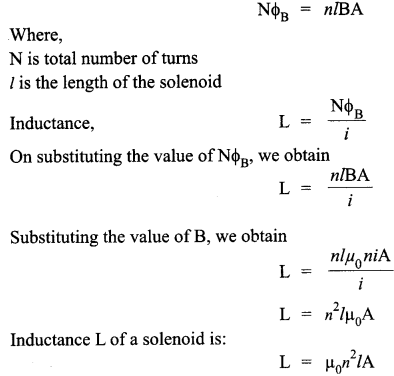
Answer 21.
For meter bridge :
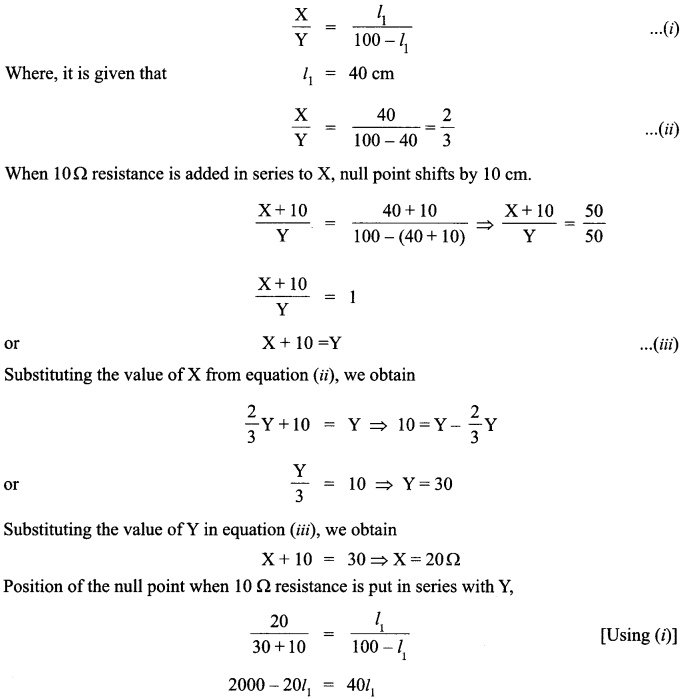

Answer 22.
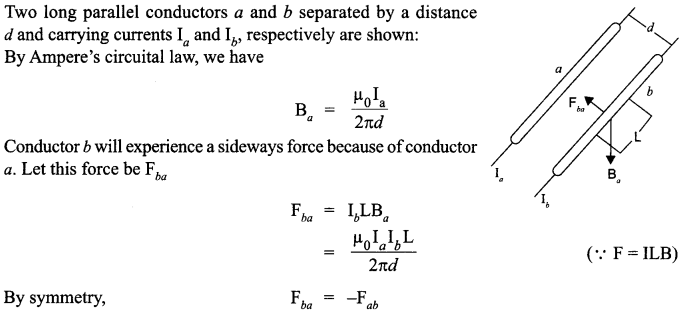
1 ampere is the value of that steady current which when maintained in each of the two very long, straight, parallel conductors of negligible cross-section and placed one metre apart in vacuum, would produce on each of these conductors a force equal to 2 x 10-7 Newton per metre of length.
OR
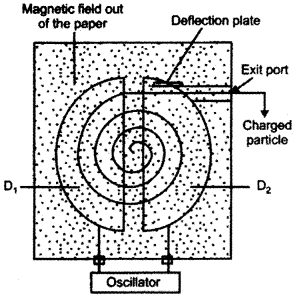
Cyclotron is a machine used to accelerate charged particles or ions to high energies. It uses both electrical and magnetic fields in combination to increase the speed of the charged particles. The particles move in two semi-circular containers D1 and D2, called Dees. Inside the metal box, the charged particle is shielded from external electric fields. When the particle moves from one dee to another, electric field is acted on the particle. The sign of the electric field is changed alternately, in tune with the circular motion of the particle. Hence, the particle is always accelerated by the electric field. As the energy of the particle increases, the radius of the circular path increases.

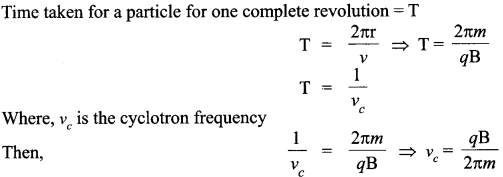
The above expression is the expression for cyclotron frequency. The oscillator applies an ac voltage across the dees and this voltage must have a frequency equal to that of cyclotron frequency.
SECTION : D
Answer 23.
- (a) Caring, love, affection and respect towards her parents.
(b) General awareness about scientific gadgets and their utilities. - In microwave oven the frequency of microwaves is selected to match the resonant frequency of water molecules so that energy from the waves is transferred efficiently to the kinetic energy of molecules. In this way temperature of any food item containing water increases.
SECTION : E
Answer 24.
(i)
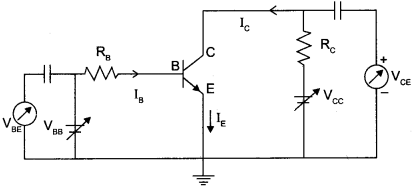
Input characteristics :
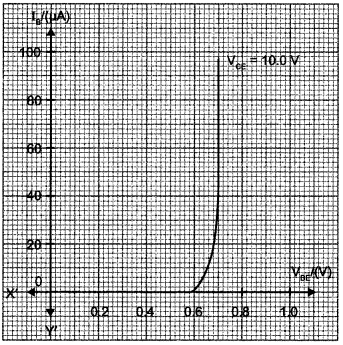
Output characteristics :
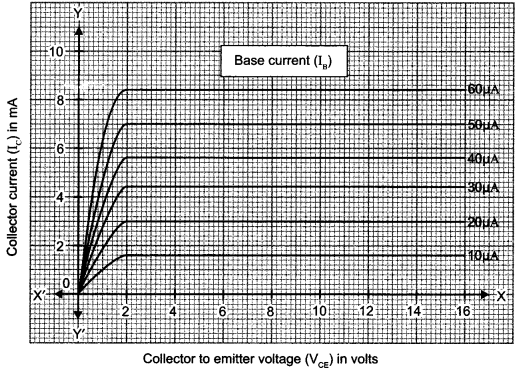
(ii) The input (base-emitter) circuit is forward and the output (collector-emitter) circuit is reversed biased. When no a.c. signal is applied, the potential difference Vcc between the collector and emitter is given by Vcc = Vce +Ic RL
When an a.c. signal is fed to the input circuit, the forward bias increase during the positive half cycle of the input. This result in increase in Ic and decrease inVcc. Thus during the positive half cycle of the input, the collector becomes less positive.
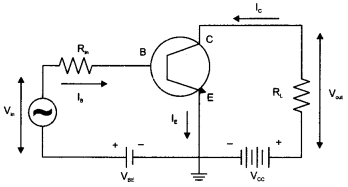
During the negative half cycle of the input, the forward bias is decreased resulting in decrease in IE and hence Ic. Thus Vcc would increase making the collector more positive. Hence in a common-emitter amplifier, the output voltage is 180° out of phase with the input voltage.
- Input signal voltage Vin = IBRin
- Output signal voltage Vout = ICRL
- Voltage gain (Av) of the amplifier is

OR
Zener diode is fabricated such that both the p-type and the n-type are highly doped. This makes the depletion region thin. When an electric field is applied, a high electric field appears across the thin depletion region. When the electric field becomes very high, it knocks off electrons from the host atoms to create a large number of electrons. This results in a large value of current inside the circuit.
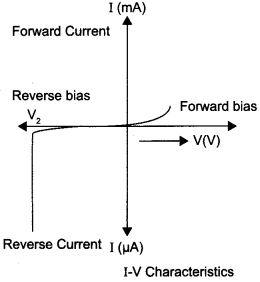
Zener has a sharp breakdown voltage and this property of zener is used for voltage regulation.

An a.c. current has a positive half cycle and a negative half cycle. A p-n junction allows current to pass only in one direction and that is when it is forward biased. When a positive half-cycle occurs, the p-side has a lower potential. Therefore, the diode is now forward biased and therefore, conducts and this positive cycle is available for the load. When a negative half cycle occurs, the «-side has a higher potential than the p-side. Hence, the diode is now reverse biased and thus, does not conduct. As a result, this negative half cycle does not conduct. Therefore, it does not appear at the load and is cut-off. We obtain a waveform, which has only positive half cycles and therefore it is called halfwave rectifier.
Answer 25.
In the given figure, image is I and object is denoted as O. The centre of curvature is X. The rays are incident from a medium of refractive index n1 to another of refractive index n2 We consider NM to-be perpendicular to the principal axis.
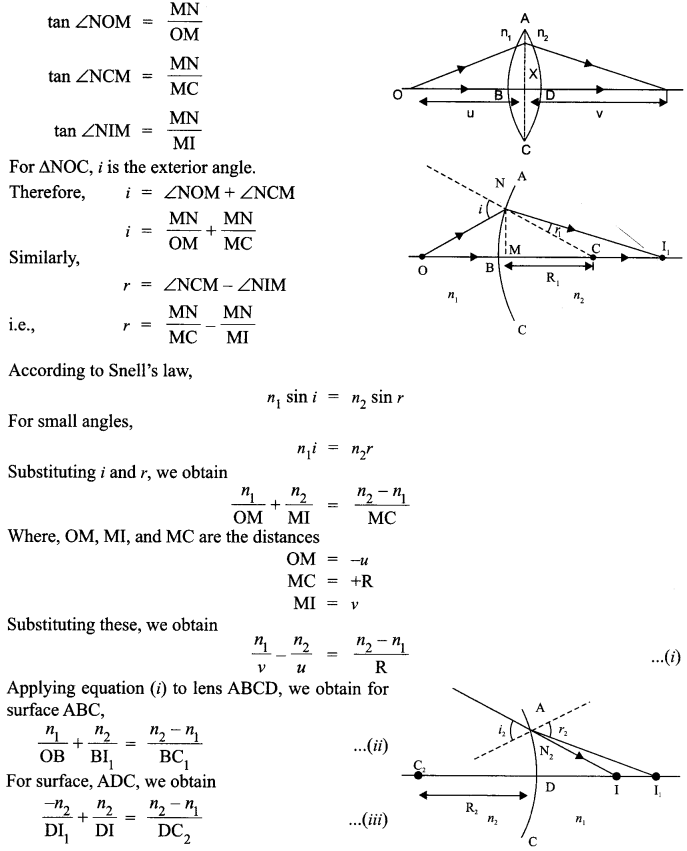
For a thin lens , BI1 = DI1
Adding (ii) and (iii) , we obtain
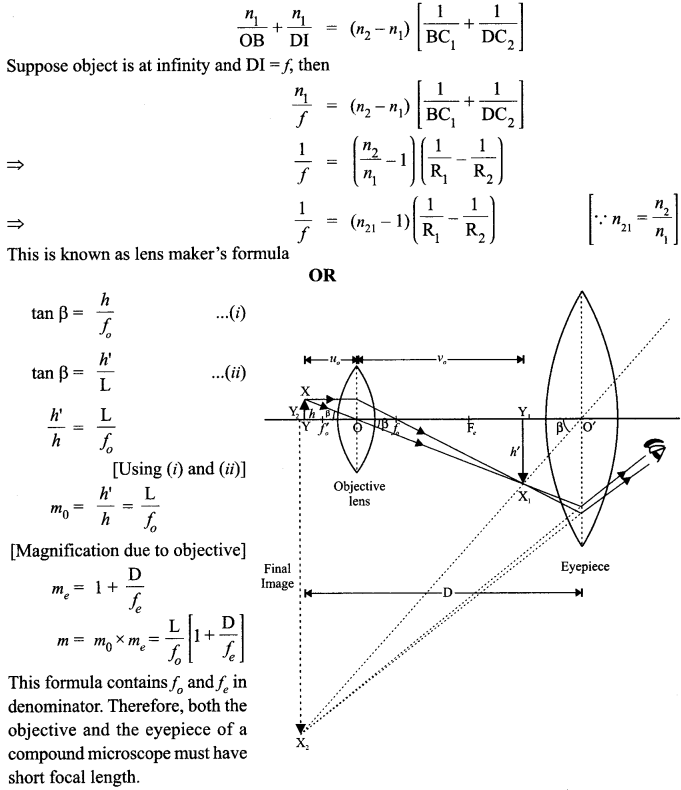
Answer 26.
(a) The rate of dissipation of energy in an electrical circuit is called the ‘power’. It is equal to the product of the emf and the current. The power of an alternating-current depends upon the phase difference between the emf and the current. The instantaneous values of the emf and the current in an a.c. circuit are given by
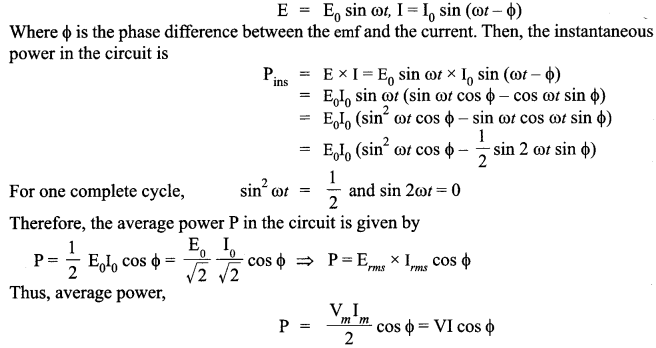
(b) Quality Factor :
It is defined as the ratio of the voltage drop across inductor or capacitor to the applied voltage.

The quality factor has high value in receiving circuits in order to get a sharp gain for the desired channel frequency. The quality factor depends on the following values :
- Inductance
- Resistance
- Capacitance
OR
(a) The instantaneous power dissipated in the resistor is
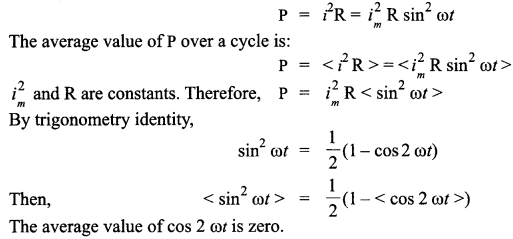
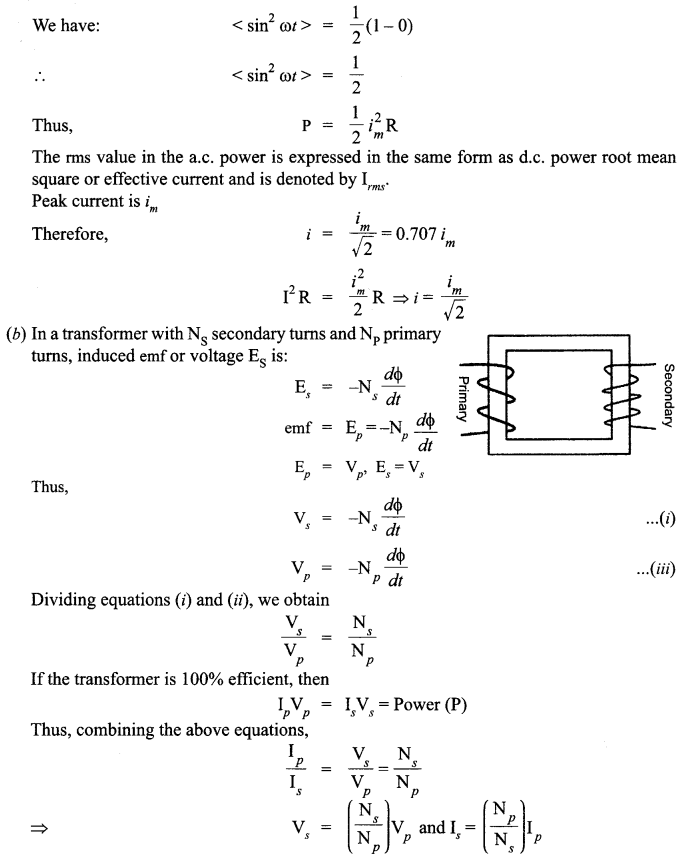
No, a step-up transformer steps up the voltage while steps down the current. So input and output power remains same, provided there is no loss. Hence, there is no violation of principle of conservation of energy.